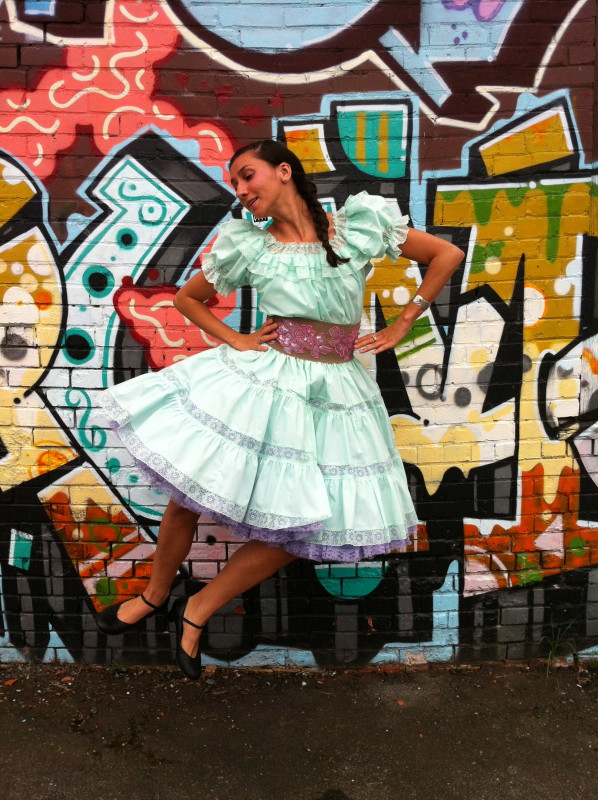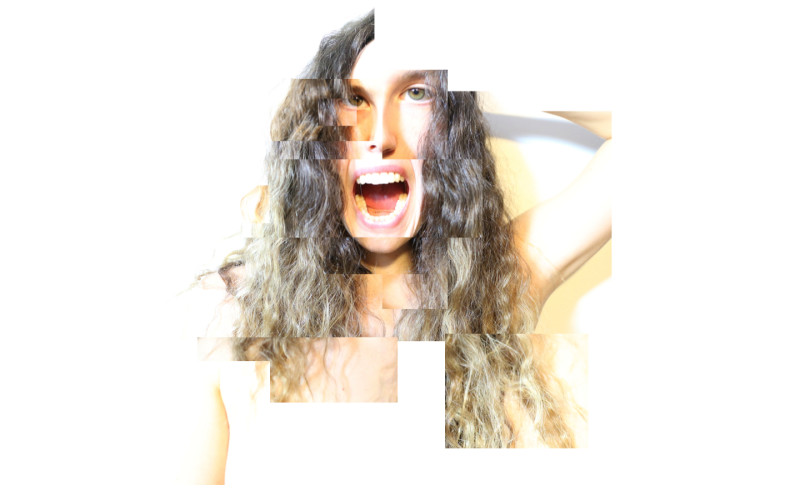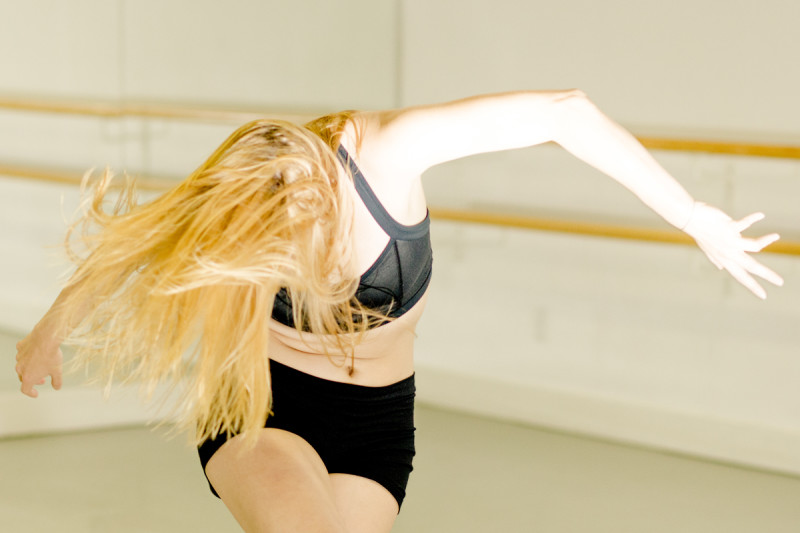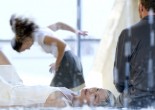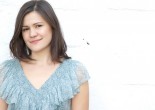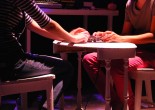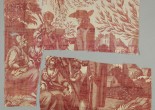Words Into Actions
Five performances at the Firehall Spring Arts Festival
Written by Dillon Ramsey
Every year, the BC Buds Spring Arts Festival at the Firehall Arts Centre showcases some of Vancouver’s best emerging and established talent in the fine and performing arts. For an entire weekend, dozens of acts happen concurrently and consecutively each day—most are between ten minutes and half an hour in length—giving audiences an exciting chance to preview the experiential and experimental works of a diverse selection of artists. This year’s lineup, coordinated by associate producer Fay Nass, includes theatre, dance, music, film, reading, installation art, and even an exhibition of emerging printmakers. “The artists can use any space and shows are happening spontaneously—there are 21 shows in 5 hours!” says Nass. “They can’t happen at exactly the same time in two rooms beside each other, or over top of one another.” She laughs. “At times, coordinating all this seemed impossible, but it’s amazing, now that the puzzle is completed.”
Upon entering the Firehall Arts Centre, the atmosphere certainly is a festive one. The foyer is cozily-lit and comfortable, and the hallway beyond the reception counter houses a cash bar serving a range of refreshments. Past all this, an outdoor patio with ample space for seating and socializing overlooks the stage where several of the evening’s dance and musical performances are set to take place. The patio’s steps lead to more tables and seating at the level of the stage, which is slightly elevated and whose backdrop consists of a beautiful mural; the various visual motifs meld street art together with local culture, and pay homage to the different communities of East Vancouver and the downtown eastside.
In a few minutes, the festive sound of an uptempo fiddle fills the courtyard, and Jeanette Kotowich takes the stage with Steppin’, a vivacious, upbeat jig which has the whole audience clapping their hands and tapping their feet. Despite the notable difficulty and intricacy of the dance, Kotowich is effortless; with her incredible dexterity and a smile on her face, she seems to be having as much fun as her spectators—if not more—and her energy and enthusiasm are infectious. She is able to maintain her pace with the music, in spite of its seemingly unpredictable accelerations, and is spurred on by the whoops and cheers of her invigorated viewers.
Steppin’ seems to be the ideal act for a spring arts festival, but there’s more to it than meets the eye: the contemporary choreography, arranged by Kotowich herself, is adapted from traditional Métis culture, as is the accompanying music. Kotowich is of Métis heritage, as is JJ Lavallee—the award-winning fiddler whose music she dances to—and her sound designer Wayne Lavallee. More than just a joy to watch, Steppin’ is an emphatic expression of cultural community and identity. And though it is a light-hearted, light-footed, jubilant expression, it does subtly set a tone for some of the darker, heavier acts to follow.
After all, the theme for this year’s Spring Arts Festival is “Longing and Belonging”, a topic selected by the associated producer to probe issues of both inclusion and isolation on personal, social, physical, and psychological levels. Nass notes how people feel impelled to seek a sense of inclusion and to flee isolation—in short, they want to belong. But then she observes how the opposite is also apt: “It seems that while we are thirsty to belong, we are also eager to separate,” she says. It’s almost as though we always want what we can’t have. “In my life I have felt that way toward my countries—both of them—toward gender binaries, cultural dichotomies, careers, academia, philosophies, friendships and relationships.” And while there are many works at BC Buds that approach this theme of longing and belonging in positive, playful, and optimistic ways, there are others that are ambiguous—and perhaps insightfully negative and pessimistic—and provoke more questions than answers.
Iris Lau’s Babel inventively employs speech, movement, and music to explore the limits of language in interpersonal communication. When the show starts, it’s only words: the dancers—Iris Lau and Carmine Santavenere—stand stiff and still, while fragments of what seems to be a nonsense dialogue in English and Chinese sound from a smartphone onstage. After a few minutes of this, they launch into motion with an intricate duet, wherein they recite phrases that literally or figuratively relate to their choreography; it quickly becomes clear that the words and sentences that are being said are the same as the recently-played recording—but whether the dance is based on the words, or the words are based on the dance, it is impossible to say. Babel‘s final act is its most beautiful, when the language is eliminated entirely, and the choreography is set to the spare music of Elliot Vaughan’s solo viola.
By reducing speech to wordless melody and pure physical movement, Babel makes its audience critically consider how people communicate in the present, both personally and remotely, and how much there is that can neither be said nor understood in language. The title of the work is extremely evocative of this—the biblical story of the Tower of Babel tells how the god of the Old Testament created a myriad of languages so that humanity would not be cohesive or coherent enough to challenge his authority. If language is indeed inadequate, muddling and mistaking almost as much as it understands, then it is worth examining alternative means of expressing ourselves—truthfully, organically, and creatively.
Things take a darker and more twisted turn with Helmeat, a work by local theatre company The Biting School. At first, the act seems to take some cues from the conventions of clowning: the performer, Aryo Khakpour, appears with his head wrapped in tin foil, which he rubs against the walls and floor until it is tight across his face; he proceeds to spin a bowl-like object—also bound in foil—across the floor several times, listening and feeling his way around the space in his pursuit of it. At first, the consensus among the audience seems to be that this is ridiculous, and the spectators chuckle regularly at the character’s clumsy and haphazard attempts to find his bowl; soon after, he leaves the room.
When he returns a minute later, his mask of foil is off and he attempts to address the audience, but a device in his mouth renders him mute—he can only speak in a low, semi-comical whistle which thwarts his ability to communicate. Once again, while this could initially be interpreted as clownish, the inhibition drives the character to an increasingly fraught level of desperation, until his violent, volatile frustration is uncomfortable—and finally terrifying—for the audience to behold; no one moves a muscle as Khakpour sits in front of his mirror and tries in vain to talk to himself, and the sheer futility compels his mania further and further. At last, when he collects himself and recovers his faculties of communication, he finally reveals the object that was wrapped in the tin foil: it is a war helmet whose interior is graphically spattered with ground beef. It’s a visceral revelation for the audience, and suddenly allows the work to be recognized and interpreted as an investigation into the complex, vertiginous void of isolation that accompanies trauma, guilt, and grief.
After a short break following Helmeat, the space has been transformed into a dressing room for Ashley Whitehead’s Wear are you?, a profoundly personal performance that incorporates dance and theatre to address issues of social acceptance, alienation, and impossible standards of beauty. Whitehead admits the audience members into the room in small groups, guiding them to where they should sit or stand; as she does so, she quietly tells them about her insecurities and seeks reassurance from them. This catches some of the spectators by surprise, and seems to leave them lost for words. Over the course of the performance, Whitehead changes outfits multiple times, critically problematising idealized body-images in the culture of marketing and modelling. And all throughout, she humorously subverts societal expectations in unexpected ways: for example, she arranges a section of the audience so that they look like they are riding an elevator, and hokey muzak fills the room—and standing amongst them, Whitehead lets loose and starts to freestyle dance to it, unencumbered by the attention she draws to herself in doing so.
The performance comes to a powerful conclusion as the room goes dark and Whitehead, silhouetted, gradually strips down to her undergarments; as she does so, she gives an intimate monologue about how a woman’s changing appearance changes her life. She recounts the experience of getting stretch marks as a girl, when her breasts and thighs were growing; she says, “‘Oh well,’ I thought to myself, ‘I guess I just won’t wear bathing suits anymore.'” It’s a simple statement, but it vividly portrays how willingly people sacrifice their own interests, joys, and passions to conform to the ideals imposed by others. Whitehead describes how as a little girl at the jungle gym, she took pride in all her cuts and bruises because they proved how active and adventurous she was: “If I didn’t have a new scar every day, it meant I wasn’t playing hard enough,” she reminisces. The show ends when she solemnly says, “I don’t know when that changed.” The lights come up, exposing the artist to her audience exactly as she is, free from the artificiality and superficiality of fashion and façade.
Returning to the outdoor stage, Meredith Kalaman’s when you’d rather sit alone rounds out the evening; while its liveliness restores a liberating sense of openness and vitality to what has proven to be a very weighty and thought-provoking festival, it is not without its own reflections on the complexities of social relations. Two dancers, Meredith Kalaman and Jen Aoki, collaborate in a series of solos and duets choreographed by Kalaman, in conjunction with three songs by Vancouver singer-songwriter Sarah Wheeler—“Weakness and Power”, “The Perfect Game”, and “Paper Airplanes”. Wheeler performs her set live on the stage with nothing save for her acoustic guitar and her powerful voice, whose precision, vibrato, and gorgeous grit is riveting to listen to. Kalaman’s contemporary dance corresponds beautifully with the lyrics, combining motion and emotion to express both the human yearning for a social bond, and the aching desire for solitude.
“Sarah and I worked on a musical documentary titled Aim for the Roses in October 2014, which is due to come out in early 2016; that film happened for me due to Mark Haney, who created and performed some of the live music for my Giraffe duet that premiered last year,” explains Kalaman. “Since working on the film together, I knew Sarah was someone I wanted to work with again, and after seeing her perform live with her band at the Railway Club I was certain we needed to perform together.” Having purchased one of Wheeler’s albums, Kalaman knew immediately that “The Perfect Game” would inspire a new dance work: “It was a song that resonated with something deep inside me movement-wise, and I knew I wanted to create to it. I had a few other songs in mind but nothing was set in stone. Once we began working, Sarah actually came to rehearsal with the other two songs saying, ‘I thought you might like to hear these,’ and then—bam!—it clicked, I saw the vision of the piece fulfilled in my mind and knew we were moving in the direction I wanted the piece to go.” Kalaman worked closely with Wheeler and Aoki to conceive this project, and describes how she would prepare the choreography while Wheeler was present so that they could dance and sing at the same time, coordinating the piece literally phrase by phrase. The end product is a symbiotic entangling of movement and sound, where the expressive theatricality of the performers melds seamlessly with the technical expertise of their dancing and the evocative power of the song lyrics.
It’s interesting to note that while the show begins with Kalaman and Aoki dancing together, they divide into solos during the second song; and while this divergence seems somewhat sombre at first, the show finishes on a celebratory high point. As Kalaman takes the stage for the finale, her sense of exuberance and exhilaration perhaps suggests that loneliness does not necessarily have to be a problem that needs to be solved—instead, it can be a creative, cathartic space that nourishes identity, individuality, and imagination. “So often in North American culture, we are guided to think that wanting to ‘be alone’ is a negative attribute, and yet society prides us on ‘being independent’ and doing things ‘on our own’; talk about mixed messages,” observes Kalaman. “In creating this trio, I intended to look at the beauty in being able to be with oneself, and the growth that is possible by being willing to look within ourselves without outside guidance or interruption. Perhaps when we truly look inside ourselves we can truly look outside ourselves, and see beyond the barriers we put up that stop us from being together.”
Altogether, this year’s BC Buds Spring Arts Festival brings together thirty diverse artworks over the span of four days, united under the theme of “Longing and Belonging”. These five works give a mere glimpse at the multidisciplinary talent and innovation here, and demonstrate the thematic threads that tie all the works together. From Kotowich through Lau to Khakpour, and then to Whitehead and Kalaman, a sort of spectrum forms. The audience is transported from a cogent and complete sense of community to a space where this sense is challenged, fractured, and begins to break down; soon, it collapses spectacularly, and a sense of aloneness has to be negotiated, and finally accepted. In the end, Kalaman’s performance effectively presents a reconciliation between enjoying a connection with others and being content with oneself, and builds a metaphorical—but profoundly meaningful—bridge between longing and belonging.

